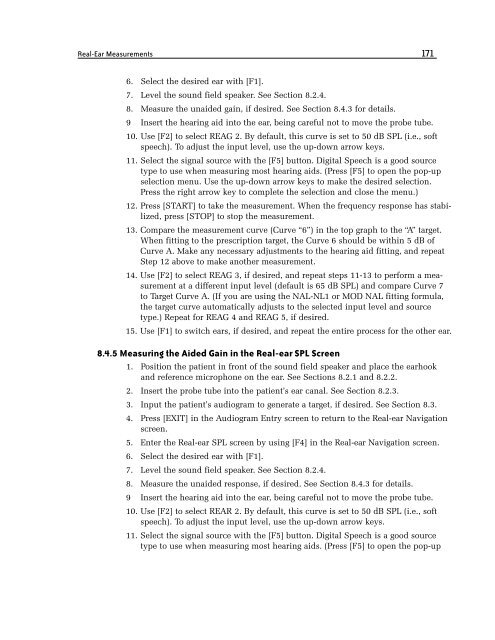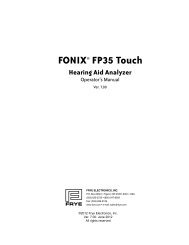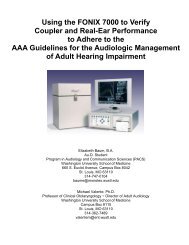FONIX® 8000 - Frye Electronics
FONIX® 8000 - Frye Electronics
FONIX® 8000 - Frye Electronics
You also want an ePaper? Increase the reach of your titles
YUMPU automatically turns print PDFs into web optimized ePapers that Google loves.
Real-Ear Measurements 171<br />
6. Select the desired ear with [F1].<br />
7. Level the sound field speaker. See Section 8.2.4.<br />
8. Measure the unaided gain, if desired. See Section 8.4.3 for details.<br />
9 Insert the hearing aid into the ear, being careful not to move the probe tube.<br />
10. Use [F2] to select REAG 2. By default, this curve is set to 50 dB SPL (i.e., soft<br />
speech). To adjust the input level, use the up-down arrow keys.<br />
11. Select the signal source with the [F5] button. Digital Speech is a good source<br />
type to use when measuring most hearing aids. (Press [F5] to open the pop-up<br />
selection menu. Use the up-down arrow keys to make the desired selection.<br />
Press the right arrow key to complete the selection and close the menu.)<br />
12. Press [START] to take the measurement. When the frequency response has stabilized,<br />
press [STOP] to stop the measurement.<br />
13. Compare the measurement curve (Curve “6”) in the top graph to the “A” target.<br />
When fitting to the prescription target, the Curve 6 should be within 5 dB of<br />
Curve A. Make any necessary adjustments to the hearing aid fitting, and repeat<br />
Step 12 above to make another measurement.<br />
14. Use [F2] to select REAG 3, if desired, and repeat steps 11-13 to perform a measurement<br />
at a different input level (default is 65 dB SPL) and compare Curve 7<br />
to Target Curve A. (If you are using the NAL-NL1 or MOD NAL fitting formula,<br />
the target curve automatically adjusts to the selected input level and source<br />
type.) Repeat for REAG 4 and REAG 5, if desired.<br />
15. Use [F1] to switch ears, if desired, and repeat the entire process for the other ear.<br />
8.4.5 Measuring the Aided Gain in the Real-ear SPL Screen<br />
1. Position the patient in front of the sound field speaker and place the earhook<br />
and reference microphone on the ear. See Sections 8.2.1 and 8.2.2.<br />
2. Insert the probe tube into the patient’s ear canal. See Section 8.2.3.<br />
3. Input the patient’s audiogram to generate a target, if desired. See Section 8.3.<br />
4. Press [EXIT] in the Audiogram Entry screen to return to the Real-ear Navigation<br />
screen.<br />
5. Enter the Real-ear SPL screen by using [F4] in the Real-ear Navigation screen.<br />
6. Select the desired ear with [F1].<br />
7. Level the sound field speaker. See Section 8.2.4.<br />
8. Measure the unaided response, if desired. See Section 8.4.3 for details.<br />
9 Insert the hearing aid into the ear, being careful not to move the probe tube.<br />
10. Use [F2] to select REAR 2. By default, this curve is set to 50 dB SPL (i.e., soft<br />
speech). To adjust the input level, use the up-down arrow keys.<br />
11. Select the signal source with the [F5] button. Digital Speech is a good source<br />
type to use when measuring most hearing aids. (Press [F5] to open the pop-up
















